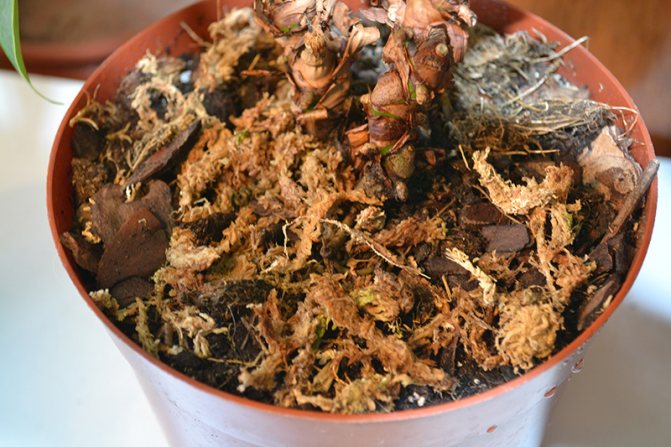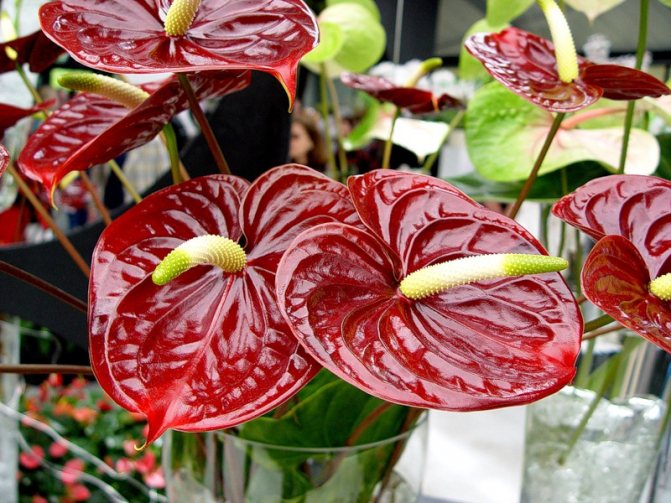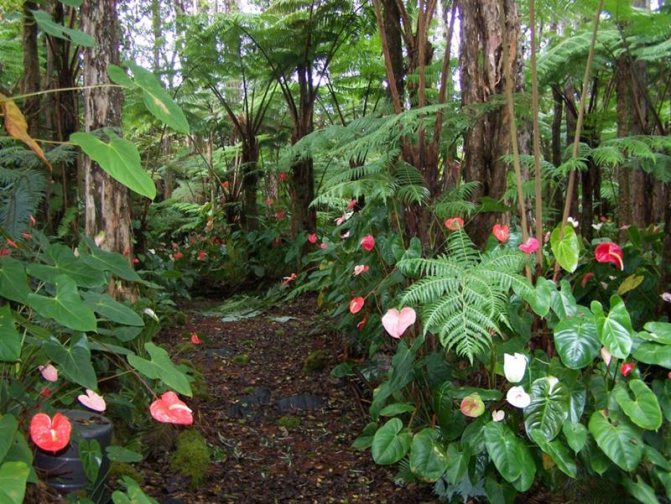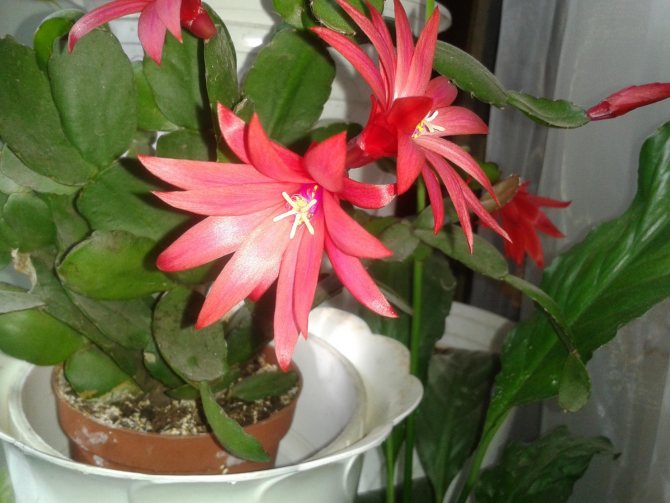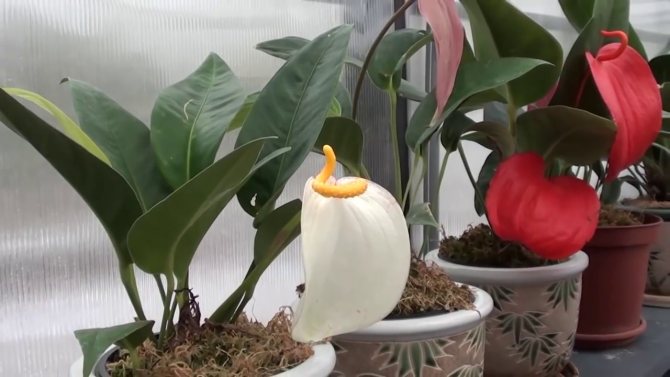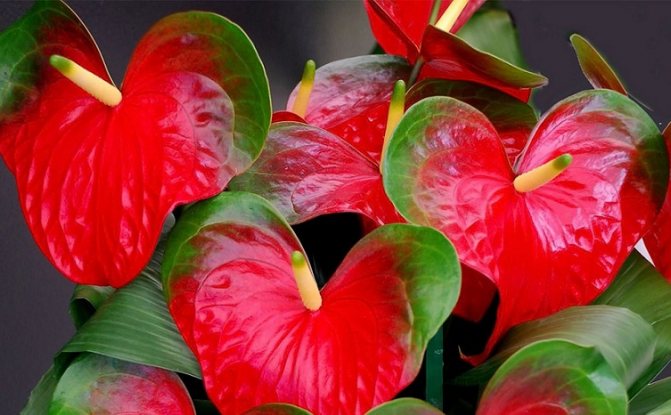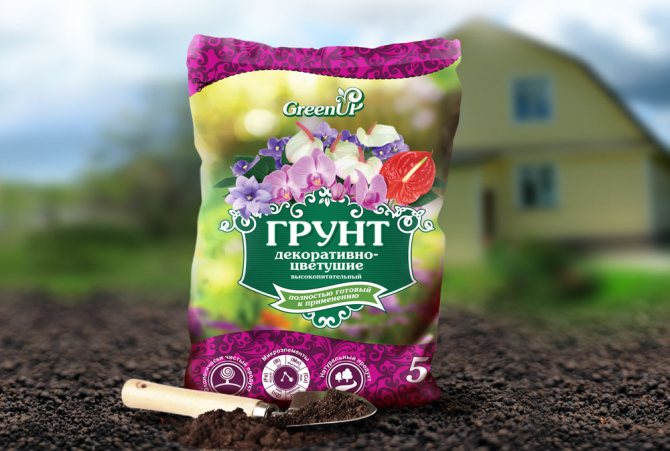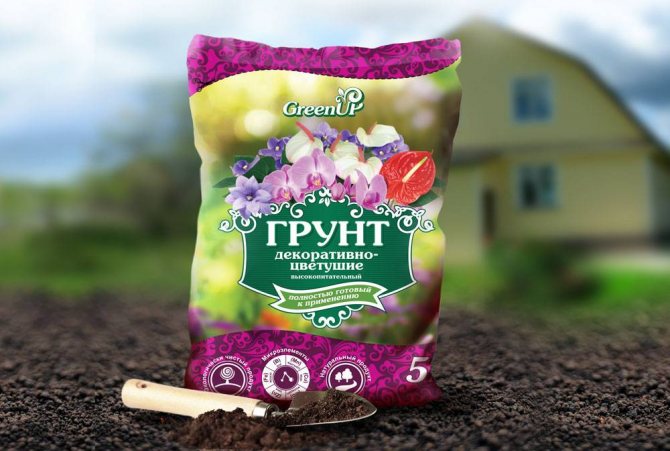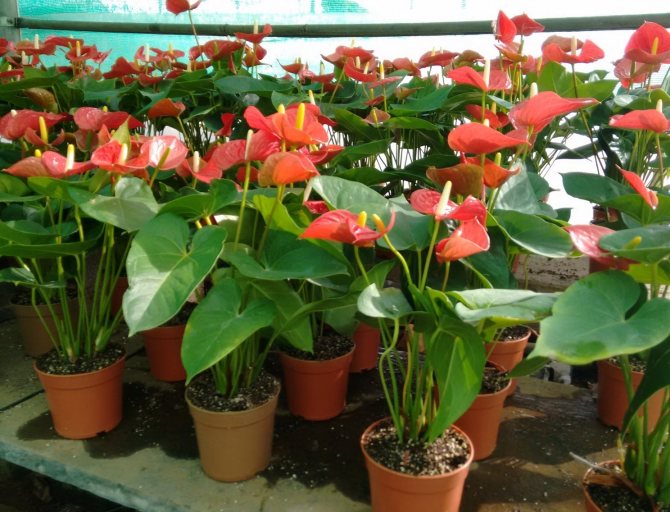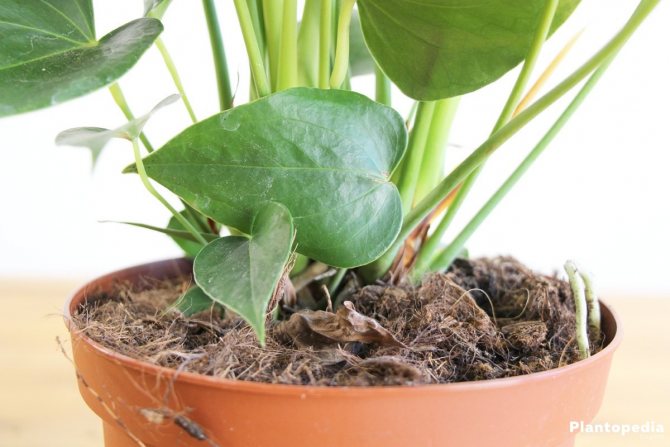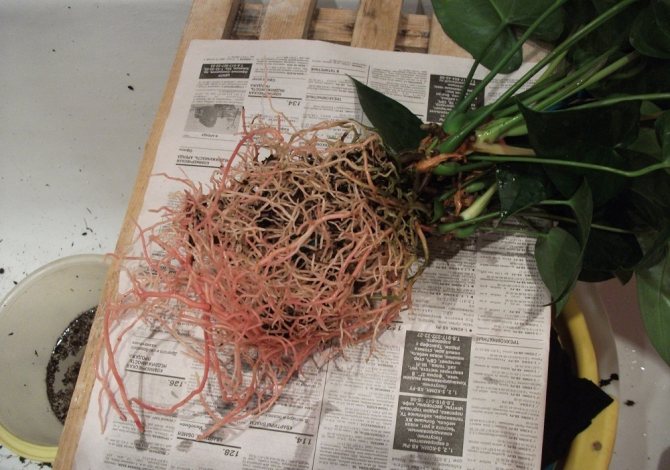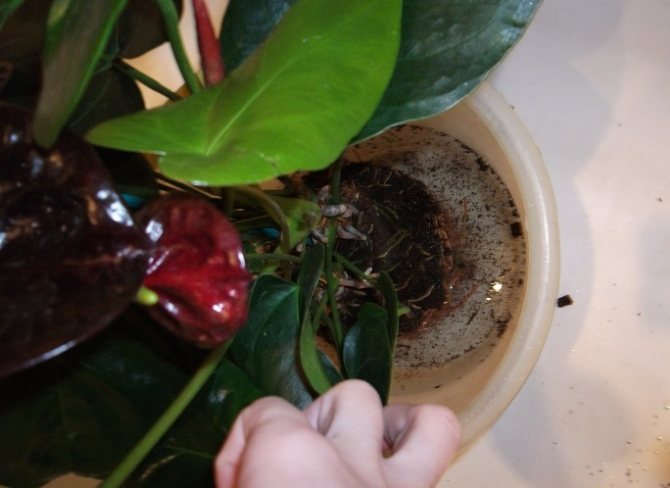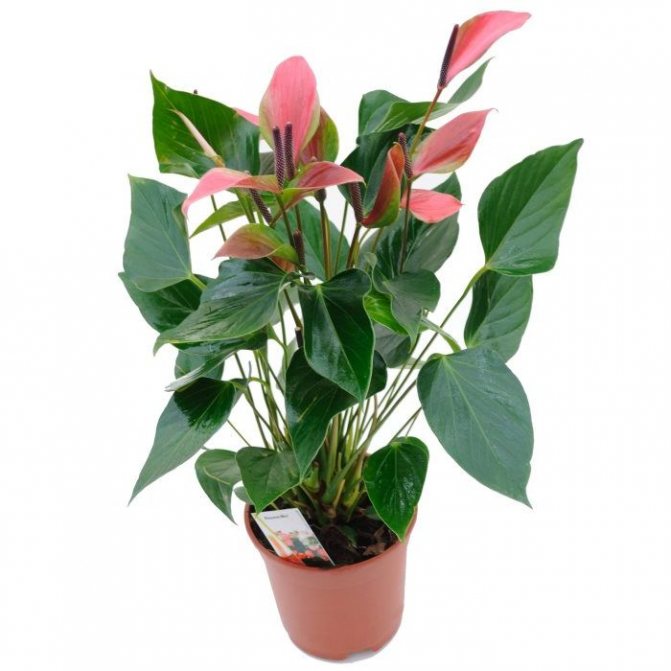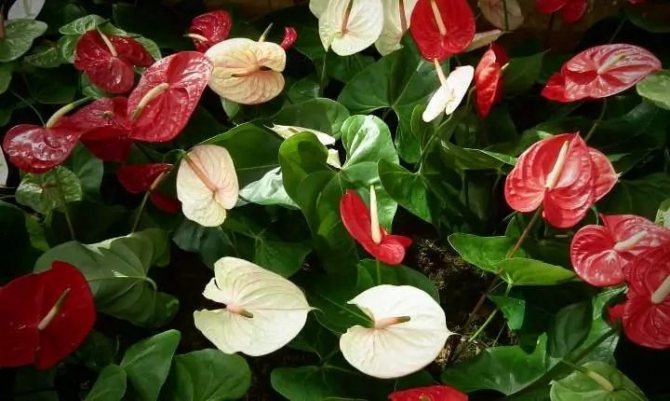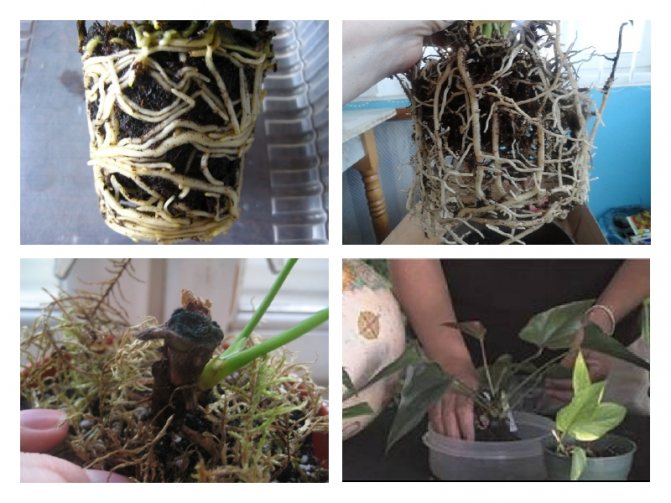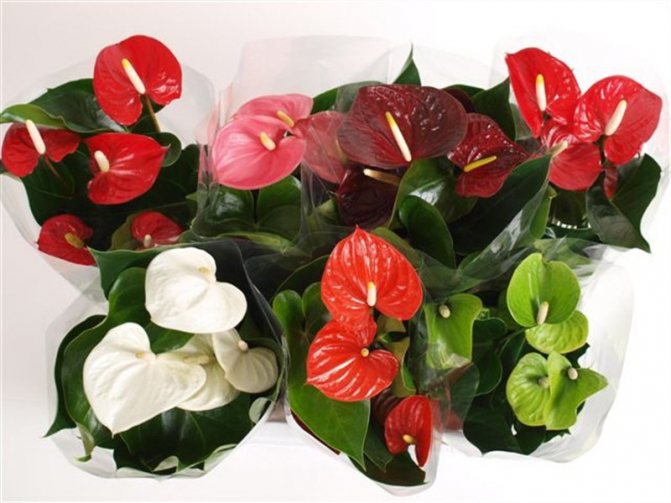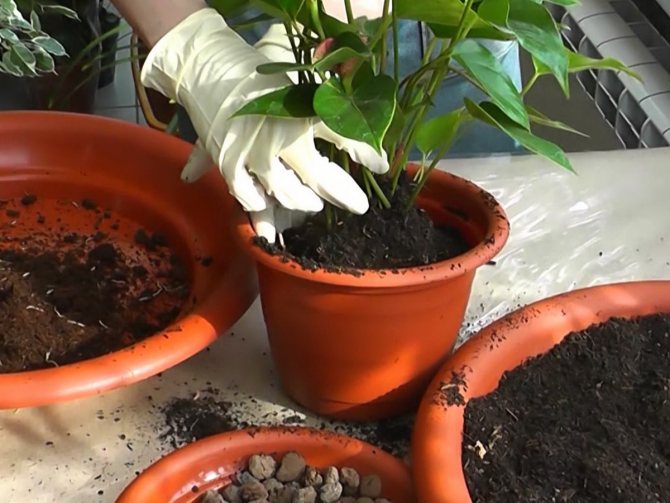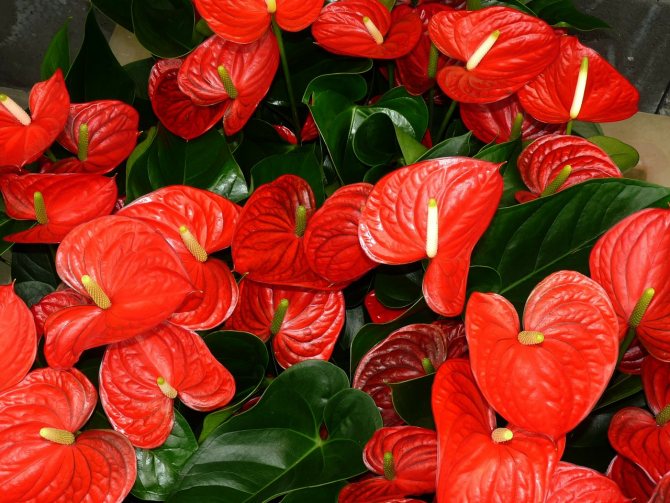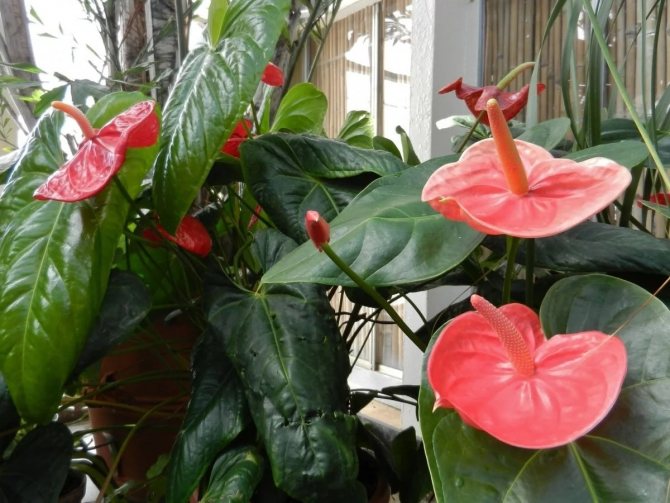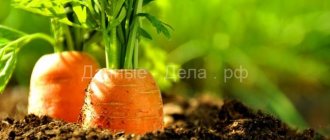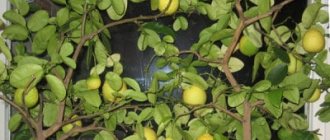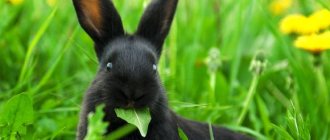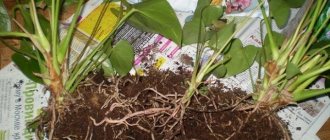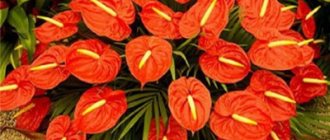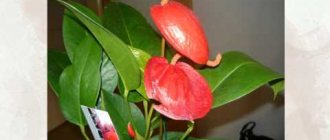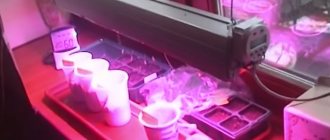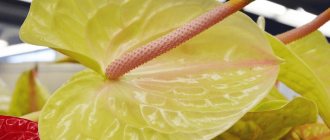Ground requirements for anthurium
Experienced flower growers know how to properly prepare the soil for planting an indoor flower. This applies to tropical plants that require external conditions close to their natural habitat. For anthurium grown in an apartment, it is necessary to maintain a constant level of humidity and temperature.
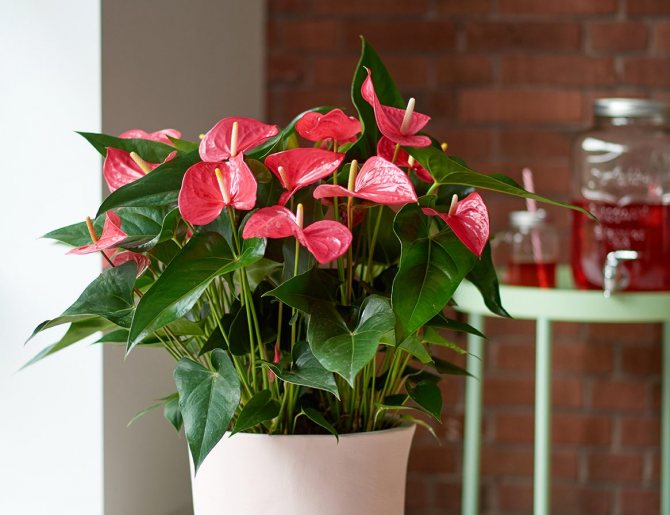
The plant blooms profusely under suitable conditions.
In the homeland of the flower, in the forests of South and Central America, it grows by attaching itself to the bark of trees or on a tree-deciduous litter. The root system of the plant goes deep into the nutrient organic layer of fallen leaves, branches, overripe fruits and berries. Nutrient biomass provides anthurium with everything it needs for normal growth and development.
Note! Garden soil is too dense for anthurium, it does not allow moisture and air to pass through well, and is poor in composition. Under these conditions, with a constant oxygen deficiency, the root system quickly decays.
Anthurium cannot be grown in a versatile potting mix that works with most indoor plants. A capricious flower needs a substrate with the following properties:
- weak acid reaction (ranging from 5.5 to 6 pH);
- ease;
- looseness;
- permeability to air and moisture;
- environmentally friendly composition.
It is possible to ensure sufficient air circulation in the root zone only if there are large-fraction drainage elements of natural origin in the soil.
What substrate should you use?
The thick dense roots of the anthurium are reminiscent of the roots of orchids. And their needs are similar. Such roots need a lot of air and moderate humidity. Accordingly, the ground for anthurium should be loose, contain a large number of air pockets, not cake or compact. And also, it is good to let water through, dry quickly. The required reaction is slightly acidic (pH 5.5-6.5).


The roots of anthurium are similar to the roots of orchids and other epiphytes.
By their nature, anthuriums belong to epiphytes and semi-epiphytes, which practically do not need land. They grow in tropical forests under trees, with roots sprouting into the forest floor from bark, fallen leaves, and various litter. It is such a loose forest floor that should imitate the ideal soil for anthuriums.
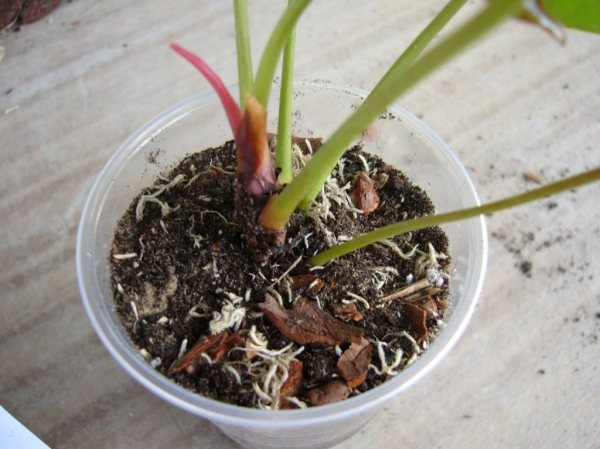

Soil for anthurium is a mixture of peat soil with bark, sphagnum moss and various useful additives
What is the composition of the soil necessary for the flower "male happiness"
Types of geraniums - what happens, popular varieties
The closest substrate in composition, suitable for anthurium, is the soil for orchids. These representatives of the tropical flora come from the same places, and the conditions for their cultivation are very similar. Both plants prefer a well-drained soil that allows moisture and air to flow to the roots, but does not dry out too quickly.


The soil must be loose
The ready-made soil mixtures recommended for the Orchid and Anthurium families usually contain:
- Peat in the composition of the soil gives it the necessary acidity, makes it lighter and more airy, provides a supply of nutrients.
- Fragments of sod litter add greater porosity to the substrate, moisture and air permeability.
- Coarse sand provides lightness of the soil and helps to remove excess moisture from the pot, thanks to which the soil remains friable.
- Leafy soil, consisting of half-decayed fallen leaves, gives looseness to the soil mixture, enriches its composition and adds acidity.
- Sphagnum moss is included in the soil for exotic plants to make it lighter. It balances the moisture level at the roots, disinfects the soil and creates suitable conditions for the adaptation of young plants.
- Over-ripened coniferous needles are another component that moderately increases acidity, giving lightness and friability to the substrate. The positive side of its use lies in the preventive effect on fungal diseases and chlorotic infection.
- The compost mixture, which is decomposed organic matter, makes the soil more saturated in composition. Due to its too strong biological activity, this element is never used in its pure form, but only small amounts of it are added to the already prepared earthen mixture.
- Charcoal perfectly drains the substrate, making its structure more permeable to moisture and oxygen. The organic component gives the soil protective qualities, serving as the prevention of fungal attack.
All these components can be included in the soil mixture in various proportions. It depends on the ratio of the listed elements what the quality of the substrate for anthurium will be.
Care of the transplanted anthurium
In order for the plant to develop normally and produce beautiful inflorescences, it must be properly looked after. First of all, it should be borne in mind that anthurium does not tolerate excess moisture well. Therefore, it is not recommended to water the bush until the topsoil is dry.
There are many useful substances in fresh soil, therefore it is recommended to apply fertilizers only after 2-3 months. If you feed the plant earlier, organic and mineral products can provoke a burn of the affected tissues. This will cause serious discomfort for the plant.
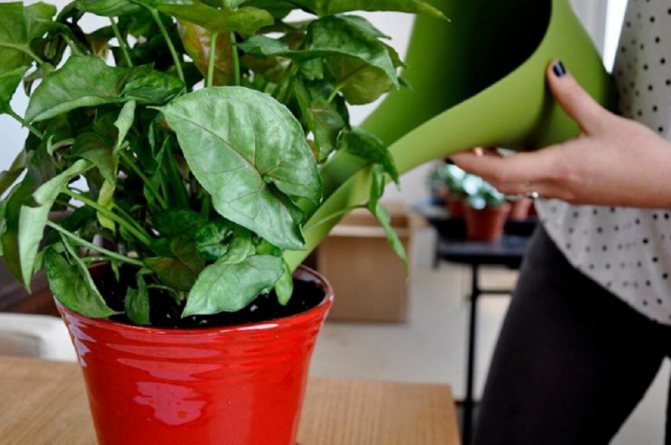

For normal development, the plant must be properly fed
Should the land for planting and replanting be different
Soil for violets - we make the best composition ourselves
A flower grower who managed to achieve the ripening of the fruits of the exotic in question may ask the question: in which land to plant anthurium? It will be easier to get seedlings from the seed by mixing the loose structured substrate with perlite or vermiculite. A good result can be achieved by placing flower seeds on a layer of sphagnum, laid out in a small flat container. When using such a moss litter, seedlings are expected to appear in 1.5-2 weeks.
Additional Information! The hatched seedlings dive after the first leaf appears on the sprouts. What land is suitable for transplanting anthurium? A substrate is used that is close in composition to the "adult" one, but consists of components of a smaller fraction.
The size
During the first years of life, young anthuriums are recommended to be replanted every year., increasing the diameter of the pot by 1-2 cm. Subsequently, the transplant of male happiness is carried out as needed every 2-3 years, while a new container for it should be chosen 3-4 cm more than the previous one.
Important! Like most of its species, anthurium is poisonous.
If its juice gets on the skin or mucous membranes, it can cause irritation, similar to an allergic reaction (itching, redness). If it enters the digestive system, the juice can cause serious poisoning.... During any manipulations that can cause damage to the plant, it is necessary to use rubber gloves, and at the end of work, wash your hands thoroughly.
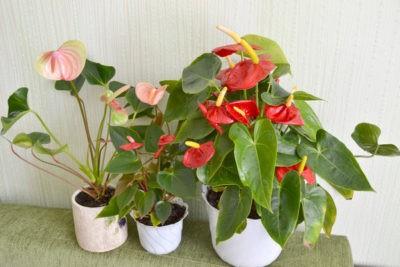

Consider in what optimal pot size to plant anthurium in the first year of life - 10-12 cm, an adult, fully formed plant will feel comfortable in a flowerpot with a diameter of 25-35 cm.
If you choose a container slightly wider than necessary, the aerial part of the plant will begin to actively grow, after some time, a large number of lateral processes and children will appear. After about a year, such a plant can be divided, thus obtaining several new flowers. At the same time, you should not count on the abundant flowering of a plant planted in such a pot.
If, when transplanting, choose a tighter container for the anthurium just a few centimeters larger than the previous one, this will lead to no less interesting results - the plant will begin to bloom actively.
It is not worth replanting the plant in a pot that is too large, as this can lead to the accumulation of moisture in the substrate and rotting of the roots. This is due to the fact that a relatively small root system cannot immediately master the entire volume of the substrate and absorb all the water from it. In this case, the liquid remains in the ground and is not removed through the drainage holes.
Pros and cons of ready-made soil and prepared by hand
Soil for orchids: soil requirements and options at home
Knowing what kind of soil is needed for anthurium, you can grow a healthy and abundantly flowering plant. The main advantage of ready-made substrates is that there is no need to spend time and effort on preparing potting mixes. It is far from always possible to check the compliance of the purchased soil with the necessary requirements:
- compliance with the proportions of the components for a particular flower (for example, the same anthurium);
- disinfection;
- acidity index.
The quality of the finished soil mixture can often be questioned. When choosing land in a specialized store, it is important to first familiarize yourself with the descriptions of various brands and make sure that the producers are bona fide.
Experienced flower growers love to mix the ground on their own. In the case of "male happiness" this is especially true, since you have to take into account his needs.
Reproduction methods
There can be many ways to reproduce anthurium, but we will consider the most common.
Division
Experienced gardeners call the reproduction of anthurium by division from the mother plant in the optimal way. This type of propagation is suitable for large mature plants. To do this, the plant is taken out of the pot and divided into parts using a sharp knife.
Sections are sprinkled with activated carbon powder. Each part should have roots and several stems. The divided parts are planted in separate pots of smaller volume. By propagating a plant in this way, you can get flowering in the current year.
In a wide pot, lateral processes are quite often formed. They can also be separated when transplanting the plant. Do not pull them out of the pot, as this will severely damage the roots of the plant.
Cuttings
The cuttings of the plant take root completely after 15-20 days, but the beginning of this process can be observed within a week. As soon as the roots grow up to 2-3 cm long, they are planted in the ground in plastic cups.
Reproduction by cuttings is carried out in the following order:
- Separate a leaf of a plant with a growth point 5-8 cm long;
- Dry the cut of the plant in air for 5-10 minutes;
- Remove the leaf blade;
- Place the stalk in moistened moss or peat with the addition of sand in a 1: 1 ratio;
- We cover the dishes with cuttings with plastic wrap and place in a warm place.
How to prepare soil mixture at home
It can be difficult to find in the store a substrate suitable for the Orchid or Aronnikov (Aroid) family, to which the anthurium belongs. There are several main ways in which the earth for anthurium is mixed, which is close in composition to the optimal indicators.


The soil for anthurium can be prepared with your own hands
Substrate based on universal soil mixture
On the basis of ordinary soil for indoor flowers, a good mixture is prepared that is suitable for anthurium. Usually, such soil already contains a sufficient amount of peat, giving it a light and loose structure, as well as creating a weak acidity.
Pine bark, crushed to a state of medium chips, is added to such a substrate. As a result, the soil becomes more drained, moisture-absorbing with excellent air permeability.
Soil-based substrate for azaleas and orchids
Another not difficult method for preparing a suitable composition is to enrich purchased soils for Azalea and Orchid with a number of additional components. The complete list of used components will be as follows:
- ready-made soil for azaleas;
- orchid substrate;
- sphagnum moss;
- coarse charcoal.
Additional Information! All elements are mixed in equal parts. The soil will turn out to be quite nutritious and structured corresponding to the needs of the anthurium.
Soil from components collected in natural conditions
Experienced flower growers use components collected with their own hands in accessible places to create soil mixtures: in the garden, in the forest, in the field. In natural conditions, you can find such components as:
- peat;
- deciduous humus;
- fallen needles of a pine or topsoil from a coniferous forest.
Before mixing the named elements, they are subjected to a disinfecting treatment. For peat and humus, steaming is more suitable, and coniferous needles should be washed with boiling water and kept in a solution of potassium permanganate.
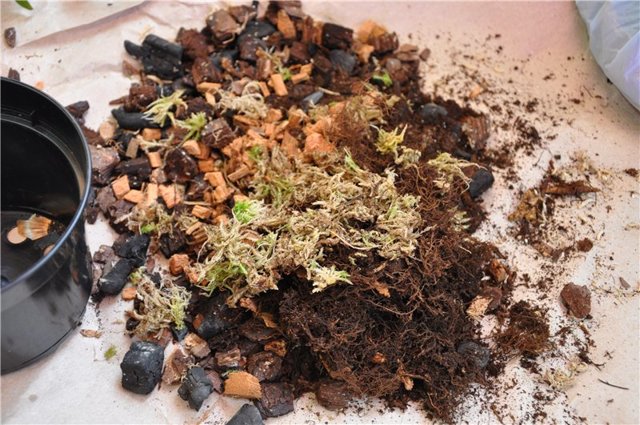

It will not be superfluous to add sphagnum, coal and dry pine bark.
How to plant anthurium by dividing the rhizome
For the procedure you will need:
- sharp disinfected knife;
- specially prepared substrate;
- drainage;
- pots for young plants.
Planting and thus rejuvenating the bush is not difficult at all. How to plant anthurium by dividing the rhizome:
- Gently remove the flower from the pot without damaging the root system.
- Cut off peduncles and stems that are too long, but retain aerial roots.
- Parts of the rhizome, together with the trunk and leaves, are carefully cut off and transplanted into new pots. All cuts are processed with charcoal.
Interesting! If you don't have coal on hand, you can use ground cinnamon. It also has some antiseptic properties.
Using this method, you can reproduce anthurium right at home, plant a flower in this way is easy, and already grown plants can be given to friends and relatives. A gift flower, according to signs, brings even more well-being to the house than one purchased in a store.


Separated parts of the rhizome
How to choose a ready-made substrate
Having decided to buy ready-made soil for anthurium, it is important to understand which composition is suitable. Despite the specificity of the composition, in specialized stores you can find ready-made substrates for the Aronnikov family. Among the manufacturers who are releasing soil brands for the Anthurium plant today, they note:
- Ultra Effect +;
- Aurica Gardens;
- For Prof;
- Rich Land.
These popular brands are of high quality. The mixtures presented by them have a suitable acidity level and an optimal content of organic components. In such a substrate, "male happiness" will feel comfortable, receiving the necessary nutrition for full growth and development. In addition to anthurium, the composition is also suitable for other representatives of the Aroid family - philodendron, monstera, scindapsus, ivy and lianas.
Note! Many manufacturers offer separate components for the preparation of soil mixtures: pine bark and coniferous needles, sphagnum, coarse river sand, peat, agroperlite, charcoal chips.
Having met the new name of the soil mixture from an unknown manufacturer, it is recommended to carefully read the composition of the soil. It will not be superfluous to analyze the reviews of those who have already used this or other substrates of the same company.
What can be added to purchased soil to improve it
The enrichment of the purchased ready-made composition will depend on what components are included in it initially. If the description says that some standard elements are absent in the substrate (for example, sphagnum or sand), then it is advisable to add them.
You can also mix a mineral complex preparation or organic fertilizer to the purchased soil. However, in order not to harm the delicate root system of the flower, you should follow the instructions on the package.


The dosage of fertilizers should be minimal
What kind of drainage is needed for growing?
The health and beauty of anthurium depends on the presence of drainagebecause these plants do not tolerate stagnant water in the root system and may die. To create optimal conditions for flower growth, you need to think about good drainage, only in this case excess water will go away and the roots will breathe.
It's important to know! Good drainage for flowers should be chemically inert, allow water to pass through, and not mold or rot.
Such materials are suitable for preparing drainage.:
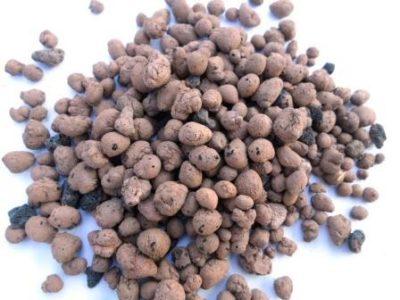

clay shards;- broken brick;
- expanded clay;
- gravel;
- crushed stone;
- Styrofoam.
The most expanded clay is a popular material for drainage, it is able to absorb excess moisture... These are burnt pieces of clay that have a porous structure. You can buy it at flower shops.
When using other materials as drainage, the following tips should be followed:
- when using clay shards as drainage, the pieces should not be allowed to be too large, since sand should be poured on top of them, and it should not spill down;
- broken brick should not have sharp edges, so as not to damage the roots of the plant, it must also be borne in mind that silicate brick is more suitable than red, as it absorbs moisture, and then gives it back as it dries;
- Styrofoam is a good drainage material, but it has one drawback: the roots of the plant grow into its structure and when a flower is transplanted, they can be accidentally damaged.
When creating high-quality drainage, the anthurium will be guaranteed comfort, it will grow well, develop and bloom.
Disinfection of the earth before planting or transplanting anthurium
Land brought from a backyard or forest contains microorganisms, bacteria, or insect pests. Having bought ready-made soil or mixed it with your own hands, it is often impossible to do without a disinfection procedure.
The soil mixture can be treated with Fitosporin, Gamair or Alarin preparations. This will kill bacteria and fungal infections.
Interesting information! Often they resort to heat treatment by steaming the soil in the oven at a temperature of at least 120 ℃ or freezing it on the balcony in winter.
Agricultural technology in winter
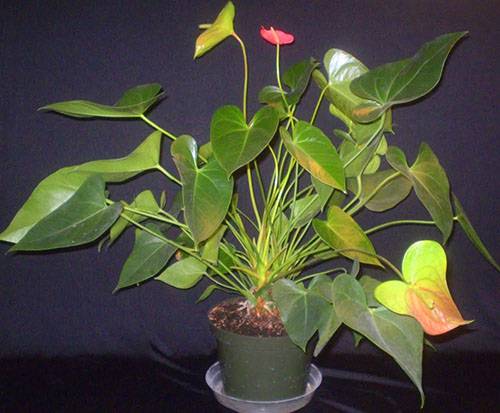

All aroids, including anthurium, have a dormant period in winter. All life processes slow down at this time. Therefore, the air temperature should be lowered to 18 degrees, but at 15 the plant will freeze. A signal that the roots are cold will be the appearance of brown spots or a completely brown leaf. Then you need to slightly warm up the legs of the plant.
Daylight hours should be about 10 hours. Therefore, supplementary lighting in regions close to the Arctic will be useful in winter. There is only 6 hours of daylight in December.Watering in winter is reduced the more, the lower the temperature, but the complete drying of the clod of earth should not be allowed. With excessive moisture, root rot is inevitable.
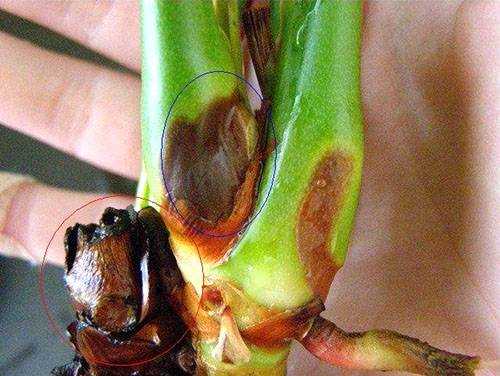

Spraying anthurium in winter is rarely done, once a week. In this case, you should constantly remove dust from the leaves with a wet cloth. Appearing yellow spots are a signal of insufficient lighting. Brown spots in the middle of the leaf indicate cold content. Drying leaf edges signal dry air. In addition, you need to examine the plant for colonization with scale insects, aphids, thrips.
Anthurium should not be transplanted in winter, you need to wait for its awakening. But if it has been poured, and the situation is emergency, then you can try when it’s not enough to reach the spring. In winter, the survival rate of the atrium is low.
Problems when growing anthurium due to improperly selected soil
Using the wrong soil can provoke root rot in anthurium. The root system is tender and sensitive, with difficulty recovering from ailments. The appearance of the disease can be signaled by black or brown spots on the leaves.
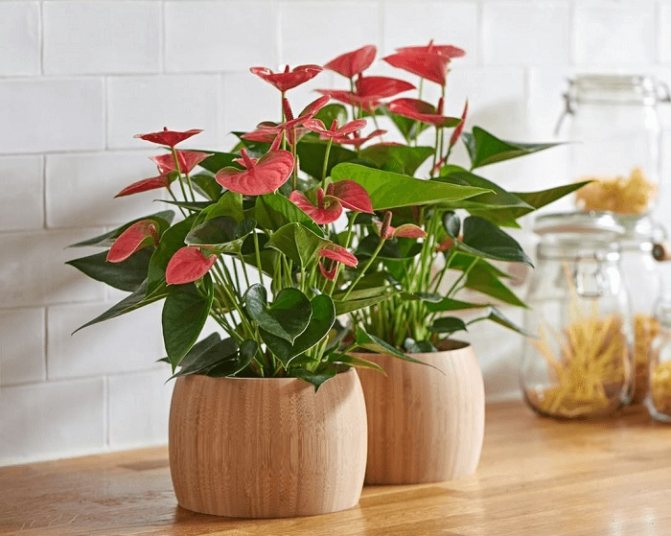

In a suitable soil, anthurium will feel great and bloom profusely.
A flower planted in an incorrectly selected substrate is urgently transplanted. The procedure itself is carried out with extreme caution. Anthurium is moved carefully, by transshipment, along with all the available root clod of earth.
Note! It is undesirable to remove the substrate in which the plant was before the time of purchase. You can only carefully remove the top layer of the soil, and spill the rest with Fitosporin.
Adhering to the specified requirements for the quality of the soil, you can grow a tropical anthurium flower near your home. The correct choice of soil will avoid problems with plant treatment, which is very laborious and not always effective.
Drainage and sphagnum moss
The right substrate is not everything.
So that the irrigation water does not stagnate in the pot and does not cause root rot, a drainage layer is poured onto the bottom of the pot - expanded clay. It is desirable to have a coarse fraction to form air pockets. Anthurium roots love to breathe! In addition, expanded clay acidifies the soil, making it more suitable for anthurium.
After planting, a small layer of sphagnum moss is spread on the surface of the soil to close the aerial roots. Moss should be kept moist by spraying it regularly.
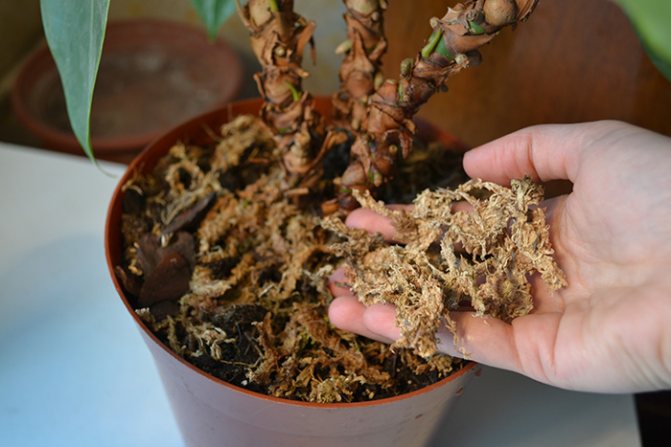

Sphagnum moss is used to maintain moisture in the aerial roots of anthurium.
It is worth noting that the correct choice of soil for anthurium will save your flower from many problems, such as rotting roots due to stagnant water and lack of air, lack of flowering, growth retardation.
Watering
Watering during the period of active growth is moderate, but regular, with soft water, that is, as the top layer dries out. I water and sprinkle with boiled water, sometimes I arrange a shower. There is an opinion that the soil should be constantly moist. The most common mistake is waterlogging of the substrate; in the wet substrate of Anthurium, the roots quickly rot, which can lead to the death of plants. Stagnation of water in the sump is unacceptable; it must be drained immediately after watering. The golden rule: it is better to almost top up than overflow. Worst of all, from constant dampness in pots, mushroom mosquitoes (whose larvae gnaw at the roots) start, pathogenic fungi and bacteria develop, various spots bloom on the plant.
Anthurium fertilizer
From March to August, feed the plant with fertilizers once every two weeks. At the beginning of the growing season, anthurium is fertilized with a weak solution for ornamental deciduous plants, after 2-3 additional dressings, fertilizers can be applied for decorative flowering plants (fertika-lux, agriculture, uniflor-bud, pocon for flowering plants, etc.). Calculate the fertilizer dose 2 times less than the recommended one.
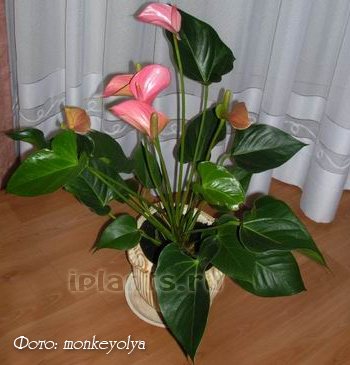

Anthurium lighting


Anthurium quickly adapts to the conditions of the room, does not like direct sunlight at noon, but it requires a lot of light, and the morning or evening sun is welcome. I also met such information in the literature: Anthuriums are shade-tolerant and can be content with rather meager light conditions.
Growing Anthuriums for more than one year, I can say that they can be content with meager light conditions, but then you will get an unattractive appearance and will not see flowers. The cuttings become very long, stick out in all directions like sticks, the leaves are small, and the flowers are even smaller, if at all. For Anthurium, any direction of windows is suitable except for the southern one, of course, you need to take into account the height of the floor, but if you really want to grow Anthurium on the southern window, then you need to put it next to the window about 30-50 cm or on the window sill, but then the window needs to be darkened.
If you have, on the contrary, northern windows, or there is shading from the street, then in winter the anthurium will be dark, and at high temperatures, this leads to the degeneration of the plant, the loss of its decorative appearance. Therefore, with such windows, from September to March, you need to turn on fluorescent lighting.
Anthurium pests and diseases
Usually, anthuriums get sick a little and are not very susceptible to pests. Most often these are scale insects and mealybugs. Sometimes ticks. Particularly dangerous are scale insects, which multiply very quickly and require serious efforts to destroy them. Ticks are fought with agents called acaricides (apollo, vermitic, nissoran, etc.). It is easiest to deal with scale insects, mealybugs and other pests, including soil ones, with systemic insecticides - this is aktara or confidor. Visible pests must be removed with a cotton swab or cotton swab dipped in alcohol.
Plants also suffer greatly from excessive watering and poor drainage, leading to decay of the root system. Root and stem rot caused by waterlogging of the substrate and low temperatures, as well as anthracnose. With anthracnose, the leaf blades begin to dry out from the edges, and with severe damage, the plants are depleted and die off. The fight against this disease requires perseverance, and it should be started when the first signs appear. In large collections, it is necessary to carry out preventive treatments with fungicides, preferably systemic (foundationol).

